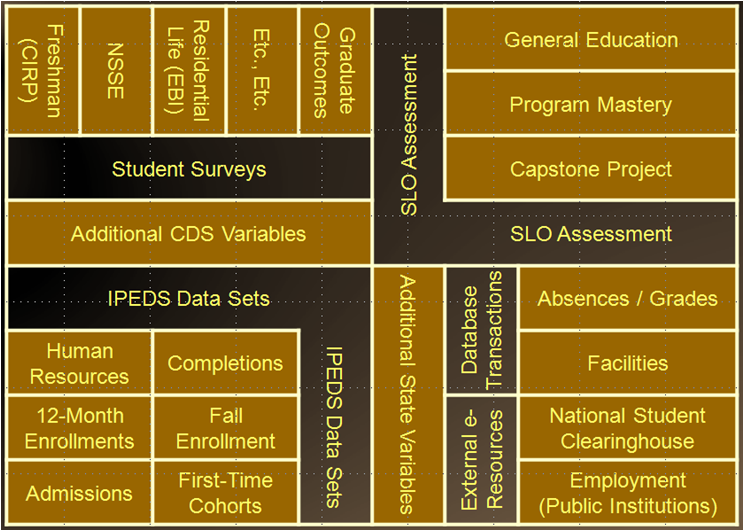Clouds
Institutional researchers oversee a bounty of information stored in student information systems and enterprise resource planning systems of colleges and universities. Yet, there is little guidance to enable IR practitioners to collectively organize their respective institutions into a large array for the systematic measurement of student success and “what works” in higher education.

Instead, technology infrastructure for institutional research is implemented at each institution as if the particular context of an institution requires a unique solution. As ad-hoc demands increase, IR practitioners’ workloads grow under the weight of student surveys and one-time projects to capture the conditions and commitments of students at a single point in each student’s college career.
History Is Written by the Victors
In 1991, the Thirty-First Annual Forum of the Association for Institutional Research featured a presentation entitled, “Science and Institutional Research: The Links.” The work of two political scientists who had no relation or experience in the field of institutional research, the scholars attended the Forum in order to dispel “the misconceptions about the ‘research’ in institutional research…” Endowed with the proper social scientific education, the two authors proclaimed, “In science there is no intent to solve practical problems, only attempts to contribute to knowledge.” Logically concluding from the premise of their ideology of pure science, the authors endeavored to help IR practitioners to understand, “Institutional research is more an art than a science.” The link, therefore, was an error in judgment.
Applying concepts from Thomas Kuhn’s philosophy of science, the authors further claimed, “institutional research is in a pre-paradigm stage,” subject to the “perceptions of those within a particular institutional context.” They conclude that the conditions for institutional research to move beyond the “pre-paradigm stage” were insufficient and suggest, in resignation, “There is little incentive for this to change.” The presentation enthralled the AIR Forum Publications Committee who “judged [the presentation] to be of high quality and of interest to others concerned with the research of higher education.” Research in Higher Education (RIHE) subsequently published the paper in its 1992 AIR edition.
The 1991 forum paper and subsequent RIHE article represent the 45-year consensus in higher education scholarship regarding the nature and function of institutional research. The characterization of institutional research as art rather than science stands at the center of the profession’s approach to the work. As artists, IR professionals create disparate reporting and analytic systems as if each institution is a canvass for the demonstration of personal talent and accomplishment. The highest ideal is to describe one’s art in the literature in order to put one’s name to an institution or research technique.
As a community of artists, we do not presume to contribute to generalizable knowledge and we take great care to please the audience that subsidizes our performance — “the perceptions of those within a particular institutional context.”
The Future of the IR Thinkpot
In the consensus argument, like that by the 1991 AIR Forum presenters, one key difference of institutional research from scholarly research in higher education is the distinction and practice of IR as an applied research rather than basic research. In 2002, with relevance for institutional research, the authors of the National Research Council (NRC) publication, Scientific Research in Education, rejected the simplicity and naivete of assumptions in the consensus literature regarding the differences between applied and basic research.
Among the many statements on the field of education and its suitability for scientific research, the NRC acknowledges that education is an “applied field” – effectively rendering moot the traditional distinction between institutional research and scientific research on higher education. “Like other applied fields,” the authors asserted, “education research serves two related purposes: to add to fundamental understanding of education-related phenomena and events, and to inform practical decision making” (83, my emphasis). Contrary to the prejudice that science “only attempts to contribute to knowledge,” as 1991 AIR Forum presenters claimed, the NRC advanced a number of guiding principles for scientific education research and design principles for an associative body to organize applied research.
Despite the intervention of the NRC over a decade ago, the consensus literature on the nature of institutional research has not been revisited, critically. The flawed assumptions and dubious conclusions of the scholarship presented to institutional researchers from the 1970s to 1990s still stands as the unimpeachable consensus. Institutional research remains, in theory, an applied research approximating “more an art than a science.”
As an alternative to a community of artists, institutional researchers could take the initiative to envision how to form a scientific research community in higher education as described in the NRC report. We offer the presentation below as an example of the application of the the principles of the NRC’s Scientific Research in Education to institutional research. We primarily focus on the role of an institutional research apparatus to improve the organization of the profession. As we have argued elsewhere in these pages, the NRC’s report aligns very well with the original aspirations of the founders of the profession to advance institutional research and science in higher education.
Click the image below to open the presentation (pdf). We recommend viewing in full screen mode.

Comments are optional, although we do encourage them.
For a complete presentation with audio, please contact us.
